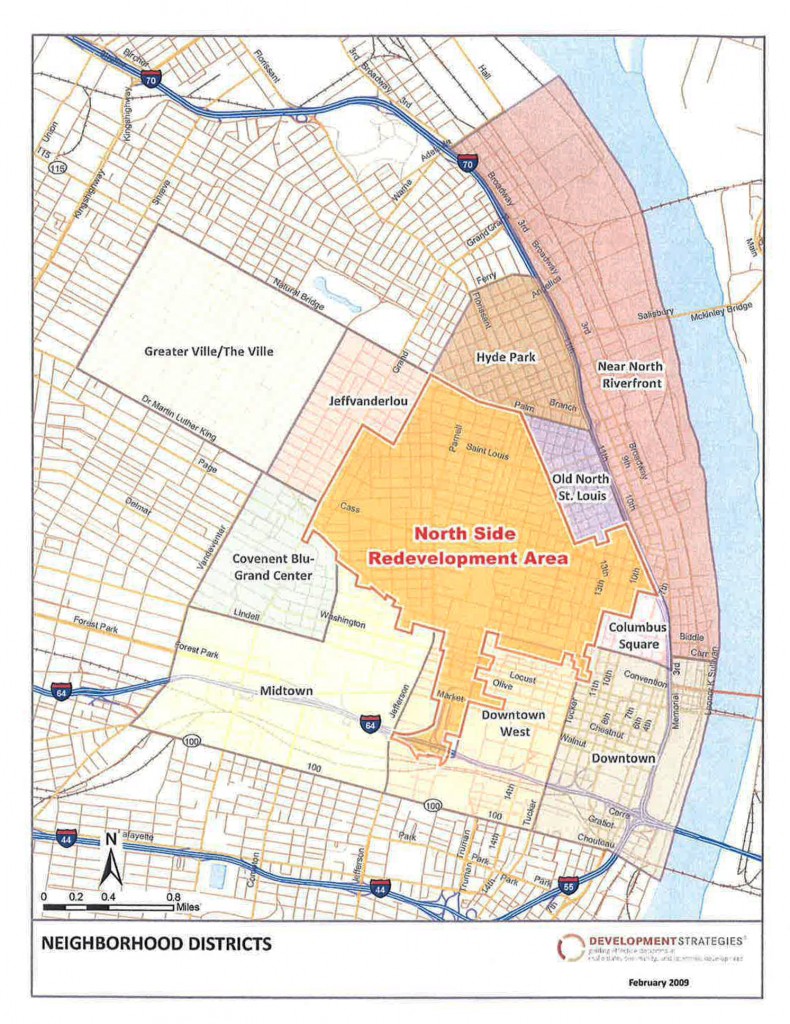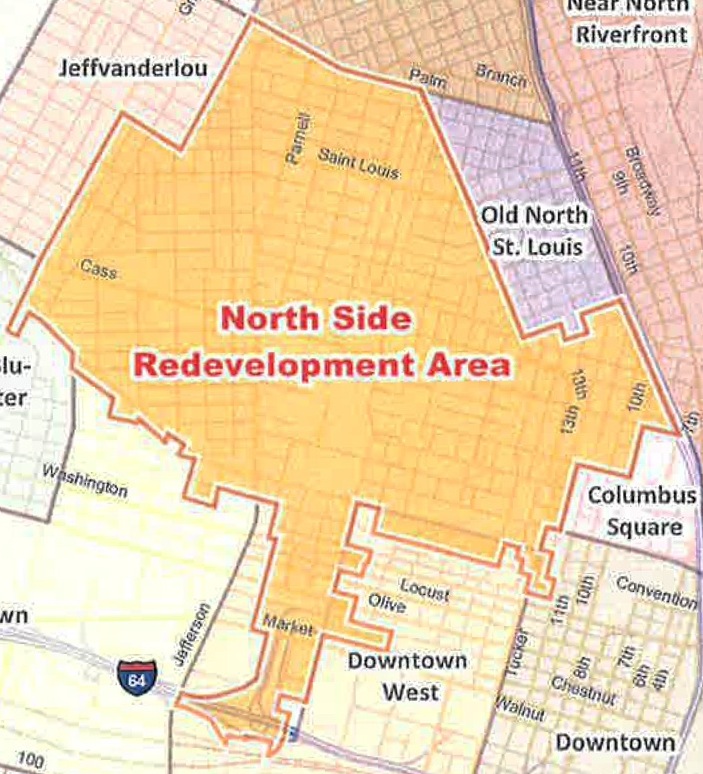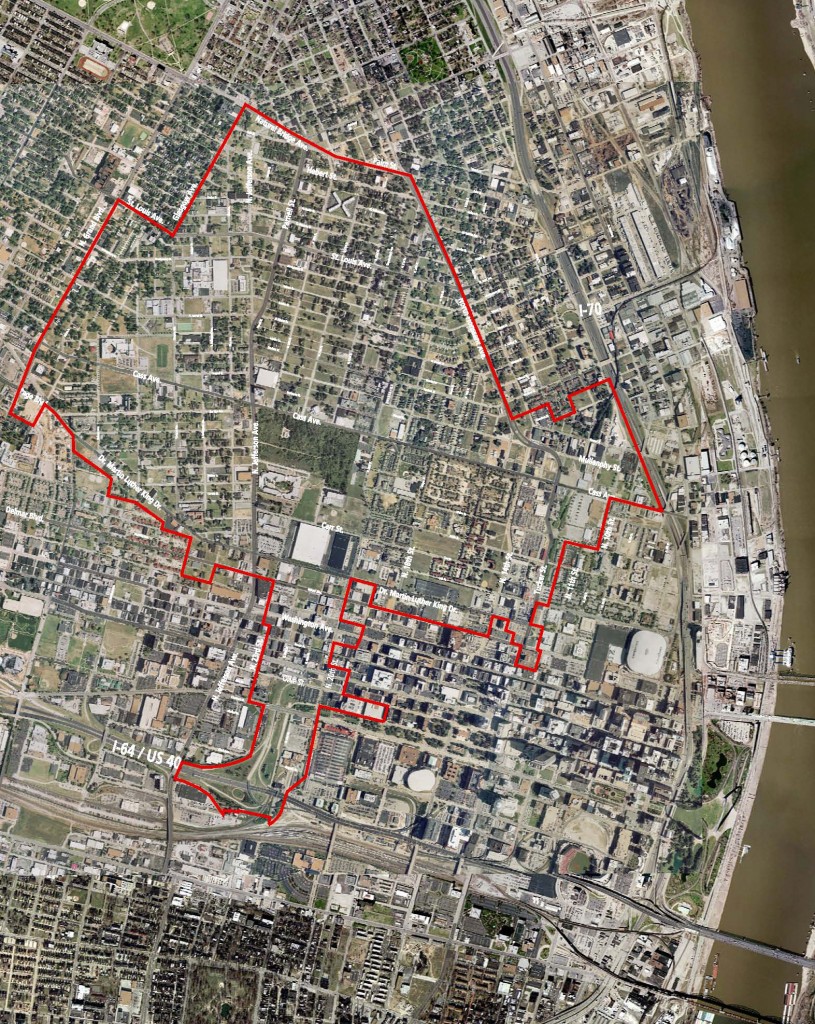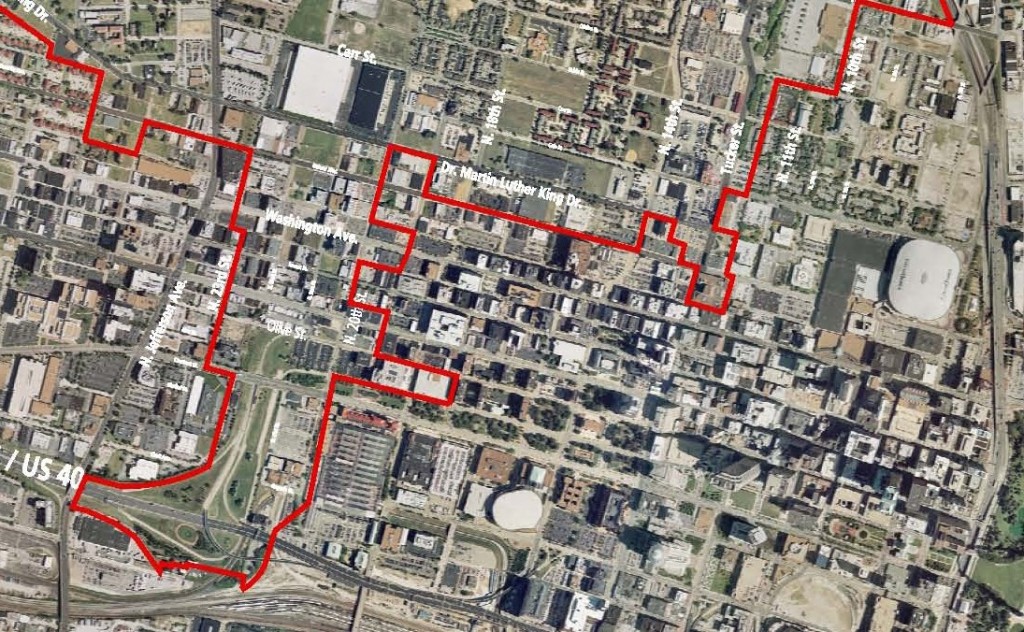For five years now Paul McKee of McEagle Properties has been acquiring properties in a large swath of land in the near North side of St. Louis. These were purchased through a long list of holding companies such as Blairmont Associates LLC. The first few years this was under the radar. But people, notably Michael Allen, began to notice the properties and their common ownership.
Many are upset about how events transpired. Quietly buying property, little to no maintenance, and so on. These issues have been hashed out here, on other sites and in the meeting on the 21st when a guy stood and called McKee a f-ing liar. I’m not going to rehash it all again. Instead I’m going to jump into the proposal.
McKee wants to partner with other developers to transform about 40 percent of the land inside a 2,100-acre redevelopment area over 15 years. McKee said he owns roughly 130 acres of the 430 acres he’d like to see redeveloped. Twelve new residential areas would be created and four new business campuses, bringing 22,000 jobs.
The plan would include about 5.5 million square feet of office, retail and warehouse space, 10,000 new homes, 250 hotel rooms and developers would welcome improved or new schools. McKee said his business does not build homes, and would work with other developers on that and other aspects.
He’ll pursue federal economic stimulus money, state tax credits and tax increment financing, where he said a portion of the increased taxes resulting from the development would be used to pay for infrastructure improvement costs. (Source: The Associated Press via Forbes.com, see Developer has $5.4B vision for north St. Louis)
Keep in mind I will graduate in December 2009 from Saint Louis University with a Master of Arts in Urban Planning & Real Estate Development. In our course of study we look at policies, their cause-effect and the full complexity of issues surrounding planning & development. I think because of this academic background I’m able to step aside from my anger at the loss of the warehouse at Cass & Tucker and the many other reasons so many are angry. Three years ago my reaction would have been quite different. So what do I think of the plan now that I’ve had a chance to see the proposal?
I like it. I don’t like how we got to this point (Urban Renewal trashing North St. Louis, city dropping the ball, McKee coming in). Typically we expect government to do what the private market fails to do. Here we turn this around, the private market is stepping in where the public sector has failed: planning. I like what it has the long-term potential of doing for the city.
To start let’s look at the project area so we know where we are talking about:

Here is the same image cropped to give you a close up of the proposed redevelopment area:

The carefully drawn boundary line includes some property but excludes others. Here is the boundary laid on top of an aerial image:


For at least a couple of decades now the city should have been doing some big picture planning (beyond a single ward) to figure out how to bring new life to this part of North St. Louis. But they didn’t. The Pruitt-Igoe site has sat vacant for 35 years. Old North St. Louis, adjacent to the project area, has taken decades (and plenty of tax credits) to get where it is today. Same for downtown and much of the city.
McKee’s plan calls for four job centers — large sites suitable for one or more companies to have a new campus setting. No surprise here, this is what McEagle does in suburban areas. This is a chance to get these jobs (and taxes) in the city. I was not able to obtain the image with the four marked sites so I have indicated them in blue below

Starting in the upper left and going clockwise we have Jefferson @ Parnell, where the new Mississippi bridge will land near Cass, the 22nd street interchange and finally in the middle left, the long-vacant Pruitt-Igoe site.
If we think about the process of redeveloping a large area you can do what Richmond Heights did with the Hadley Township area. Draw a boundary and put all the properties inside up for development proposals. Not surprisingly the residents there who’ve lived in flux while proposals came in picked not the best plan but the plan that would give them the most for their homes. After being in play for several years the owners were told the developer couldn’t come through. Same thing happened in Sunset Hills and elsewhere throughout the country. Often municipalities put areas up for development not because they are distressed but because they are chasing limited sales tax dollars. McKee has gone a different route. One based not on Ward boundaries but on where development potential exists.
While I love the rebirth happening in Old North St. Louis, without some serious infrastructure investment we’d not see much happening in the outlined development area.
“A tax credit for one man” is often heard about the Missouri Land Assembly tax credit written by McKee’s attorney. To be precise it is a tax credit for one company. But many companies will be involved. Others own land within and adjacent to the development area, including individual owners.
TIF financing will be used, no doubt, to fund massive improvements in public infrastructure, bridges, roads, sidewalks, sewers, etc. Will McKee & company make money? Yes, of course. We all need to make money. The question is if the outcome will justify the level of public investment. I hope so. I’m waiting to review the financing proposals. Remember that a “TIF” is tax increment financing. As property taxes rise due to the development that increment of increase is paid by the owner — yes, they pay the higher tax. That increment is used to pay off bonds used to build public infrastructure. Development & infrastructure are both needed here. The city doesn’t have the money to build the infrastructure to attract the development. McKee’s proposal may be the only way to redevelop this section of our region.
I am excited about the potential this project brings to the city & region. A chance to get some large new employers — or to retain the ones we’ve got. A chance to change perceptions about North St. Louis. A chance to fill in the many gaps in our building stock. A chance to add needed population. A chance to get a modern streetcar/trolley line connecting the project area to downtown. A chance to get thousands of parcels of land out of city ownership.
Before someone suggests I was bought off I can assure you I’m still a struggling grad student. I’ve met Paul McKee twice — the 1st time 3-4 years ago at a meeting of the Dardenne Prairie Board of Aldermen. The 2nd time was at McKee’s presentation last Thursday. This 2nd time he knew who I was and he offered his card. After a couple of emails I got the above images out of him, nothing else.
But while I like the big picture planning involved I have reservations about the follow through on the project. Paul McKee promised New Urbanism at WingHaven but delivered a half-assed cartoon version. The St. Louis Board of Aldermen, as a general rule with a few exceptions, do not get what compromises walkable urbanism. How will they know what to require of McKee? To be sure our old 1947 zoning needs to be tossed aside for this area. A new form-based code needs to be laid over the project area to guide future development to ensure we get what we are promised.
I want this project to succeed — financially & urbanisticly. I want to live along the trolley line. I want St. Louis to be a city of 500,000 people again in 20-25 years.
Selected articles for further reading:








